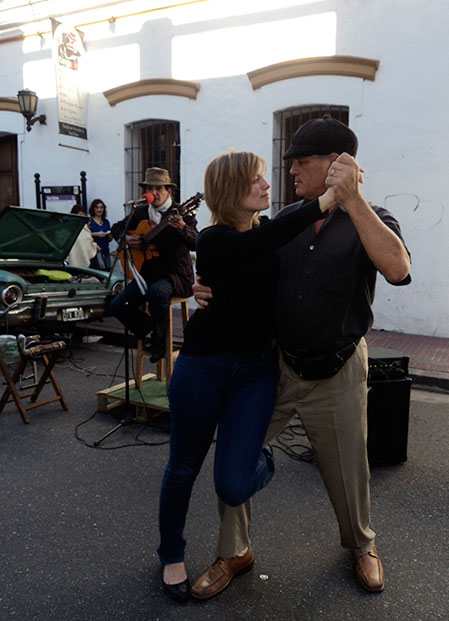Tango is more than a dance. It can teach us a lot about how to grow as people, individually and in relationship.
I fell in love with tango at first sight when I was traveling in Colombia in 2010. I moved to Buenos Aires in October 2012 to soak up tango culture at the source.
Many people traverse the world to live in Buenos Aires, to dance tango four or five nights a week. More is going on than just the pleasure of the dance, which is in of itself immense. Tango sweeps you up and helps you get more intimate with yourself and in your relationships with others. Tango is a personal quest, whether the person recognizes that or not.

Alejandro Gee is a tango teacher who did his graduate thesis in psychology on the effects of tango dance on mood. He writes, “The posture of a person is not just a position that we are supposed to stand/dance in, but also a reflection of who we are. The way we connect or the way we lead or follow are also a perfect reflection of our social, emotional and mental status. Usually 10 minutes into the class you can tell more about a person’s character or the relationship within a couple than you could after talking. This is why tango has the capacity to heal issues that we are or not aware of. By fixing the physical, the mind and emotions will follow. Or we will want to heal the mind and the emotions in order to be able to improve our dancing.”
The search for balance and stability within yourself
One of the most powerful searches in tango is the search for being in axis, or eje, as they say in Spanish. Being in your axis in dance means using the energy of the floor to find your own balance in your body, so no matter what you are doing, pivoting, turning, or walking, you are in control of your own movement.
Tango is paradoxical. The beautiful paradox of tango is you have two people who are leaning in toward each other, absolutely connected, exchanging energy through a chest-to-chest heart connection in an abrazo (hug), but each one of them should be so solid in their axis that if the other person disappears he or she does not fall down. He or she stays standing because she is rooted in her axis. When you and your partner have both the connection to each other and the connection to their own bodies in their own axis, you have magic.
For a woman the search for the axis is a very powerful metaphor. A woman is traditionally defined by relationship to other. (And she is in tango too, it does take two.) As a mother, a lover, a friend. Her value is defined through the other.
When you have your axis too, you know you are also all right on your own. For me, feeling my axis, this alignment of my body that puts me into a stable, independent and yet connected position when I dance, feels like a revelation. I feel heaven open up. I feel powerful and smooth, connected and independent. It took me over two and a half years of consistent tango study to find my axis, in shimmers and glimmers. It’s a big deal, cause for celebration.
The metaphor of tango for a healthy relationship
Enter tango. Tango, though rooted in an era when women were not equal, with decidedly machista roots, is such an apt metaphor for a healthy relationship. The dance itself brings masculinity and femininity together in such a way that both need to be rooted in themselves in order to dance. To create a dance—or a relationship where both people get to be fully alive, both have to be in their axis. Passion and connection with another depends on a deep connection with yourself.
A tango teacher Luciana Rial Baumgartner was once teaching me how to do a fast turn with her. You need to have the right amount of tension between the two people in order to generate the connection. That tension is created because each person has a strong core and while dancing for the other, he or she is also dancing for herself, making sure her body is in alignment. That tension creates the thrill.
Luciana said, “First, you must dance for yourself.”
When you get all floppy in your core the dynamic falls apart. One person starts putting pressure on the other. She compared the dynamic to a romantic relationship. When we get floppy in terms of our own personal alignment in life, the connection suffers because we prioritize the connection with the other over the connection with ourselves.
When we’re single, we lose our axis when we think we need to change who we are to attract someone, or when we think there’s something wrong with us or our lives because we are alone.

When we’re in a relationship, we lose our axis when we stop doing things we love and become fused. We change who we are to please the other; he likes golf, I’ll like golf, and so on. We get obsessed and let a relationship or its demise determine our self-worth. We fear being alone and don’t feel we can be alone.
Most of us have lost our axis in relationship. That’s how we grow, we learn what it’s like to lose it. We evolve to a healthier relationship pattern put in the work to find our axis. In life. In ourselves.
Finding your axis is a process. Repeat. Repeat. Repeat.
Studying tango–and continually finding and losing and finding my axis again–feels to me like putting a metaphor for relationship into my body. It helps me to remember, this is what it is to lose your axis in tango, this is what it is to lose your axis in a relationship, and this is what it is to find it again.
In the dance, as in life, it’s not like you find your axis once and stay there in perfect alignment (unless you are a professional dancer, maybe, with perfect posture). You find it, you lose it, and you find it in your body again. Dancing and life is a process of learning how to sustain your axis more and more consistently over time. You lose your balance. You realize you lost it. You reset. We do the same thing in our lives as we lose our centers and then come back to them again. The question is whether we notice and how quickly we recover back to ourselves.
Want to learn more?
 Sasha is hosting a tango salon (house party) in the Mission on Thursday, March 6 where she’ll speak about what she’s learned in Buenos Aires studying tango, about the metaphor of tango for a healthy relationship, and how we can use the wisdom of tango off and on the dance floor. As part of the party, she’ll tell you about a Tango Adventure tour she is hosting in Buenos Aires, May 24-31, and how Bay Area tangueros can join! If you’re interested in coming to the house party March 6 email her at sasha at sashacagen.com with the subject line: tango party.
Sign up on Facebook: Tango salon on Facebook
Sign up on Meetup: Tango salon on Meetup
Learn more about Sasha’s tango trip at: http://sashacagen.com/tango-adventure
Sasha is hosting a tango salon (house party) in the Mission on Thursday, March 6 where she’ll speak about what she’s learned in Buenos Aires studying tango, about the metaphor of tango for a healthy relationship, and how we can use the wisdom of tango off and on the dance floor. As part of the party, she’ll tell you about a Tango Adventure tour she is hosting in Buenos Aires, May 24-31, and how Bay Area tangueros can join! If you’re interested in coming to the house party March 6 email her at sasha at sashacagen.com with the subject line: tango party.
Sign up on Facebook: Tango salon on Facebook
Sign up on Meetup: Tango salon on Meetup
Learn more about Sasha’s tango trip at: http://sashacagen.com/tango-adventure